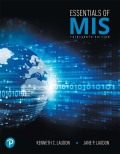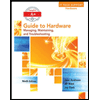
EBK ESSENTIALS OF MIS,
13th Edition
ISBN: 8220106778494
Author: LAUDON
Publisher: PEARSON
expand_more
expand_more
format_list_bulleted
Expert Solution & Answer
Chapter 7, Problem 1RQ
Explanation of Solution
Features of simple network:
- The client computers, server computer, network
operating system software, network interfaces, hub, and a connection medium are the entities of a simple network. - The basic responsible for network operating system software is controlling the network and its functions.
- One client computer is connected to another client computer within the same network.
- Hubs and switches function is sending packets of data to all other linked devices.
- The network helping up web pages to storing data and network operating system.
- The switch has the capability to select a particular destination while the hub sends a packet to all other linked devices.
- The network components links with the connection mediums such as coaxial cables, radio signals or telephone wires.
- The Microsoft Window Server, Linux and Novell Open Enterprise Server are the most commonly used network operating system software...
Explanation of Solution
Principal technologies and trends:
- Client/ Server computing
- Packet switching
- TCP/ IP and Connectivity
Client/ Server computing:
- Client/ Server computing is defined as a distributed computing model where a part of the processing power is placed within cheap client computers and exist in laptops, handled devices or desktops.
- It also allows for computing to departments, factory floors, workgroups and other parts of a business that couldn’t be worked by a centralized architecture.
- The clients are linked to other clients through networks that is controlled by a network server computer.
- It has replaced by centralized mainframe computer.
- The process of the client/ server computing has no longer take place on a central large mainframe computer.
Packet Switching:
- Messages transferring in the internet are divide into fixed size unit of data called packet.
- Messages are divided into packets to increase the performance and reliability of the internet.
- Ιt also improves the effectiveness of the communication line in the internet.
- Packets travel through several routers before it reaches the destination.
- Router is a device that provides a path for the packet to reach the destination...
Expert Solution & Answer
Want to see the full answer?
Check out a sample textbook solution
Students have asked these similar questions
Show all the work
Construct a frequency polygon density estimate for the sample in Question 1, using bin width determined by Sturges’ Rule.
Show all the work
Chapter 7 Solutions
EBK ESSENTIALS OF MIS,
Ch. 7.3 - Prob. 1CQ1Ch. 7.3 - Prob. 2CQ1Ch. 7.3 - Prob. 3CQ1Ch. 7.3 - Prob. 4CQ1Ch. 7.3 - Prob. 5CQ1Ch. 7.3 - Prob. 1CQ2Ch. 7.3 - Prob. 2CQ2Ch. 7.3 - Prob. 3CQ2Ch. 7 - Prob. 1IQCh. 7 - Prob. 2IQ
Ch. 7 - Prob. 3IQCh. 7 - Prob. 4IQCh. 7 - Prob. 5IQCh. 7 - Prob. 6IQCh. 7 - Prob. 1RQCh. 7 - Prob. 2RQCh. 7 - Prob. 3RQCh. 7 - Prob. 4RQCh. 7 - Prob. 5DQCh. 7 - Prob. 6DQCh. 7 - Prob. 7DQCh. 7 - Prob. 8HMPCh. 7 - Prob. 9HMPCh. 7 - Prob. 10HMPCh. 7 - Prob. 11HMPCh. 7 - Prob. 13CSQCh. 7 - Prob. 14CSQCh. 7 - Prob. 15CSQCh. 7 - Prob. 16CSQCh. 7 - Prob. 17CSQCh. 7 - Prob. 18MLMCh. 7 - Prob. 19MLM
Knowledge Booster
Similar questions
- Show all the workarrow_forwardShow all the workarrow_forward[5 marks] Give a recursive definition for the language anb2n where n = 1, 2, 3, ... over the alphabet Ó={a, b}. 2) [12 marks] Consider the following languages over the alphabet ={a ,b}, (i) The language of all words that begin and end an a (ii) The language where every a in a word is immediately followed by at least one b. (a) Express each as a Regular Expression (b) Draw an FA for each language (c) For Language (i), draw a TG using at most 3 states (d) For Language (ii), construct a CFG.arrow_forward
- Question 1 Generate a random sample of standard lognormal data (rlnorm()) for sample size n = 100. Construct histogram estimates of density for this sample using Sturges’ Rule, Scott’s Normal Reference Rule, and the FD Rule. Question 2 Construct a frequency polygon density estimate for the sample in Question 1, using bin width determined by Sturges’ Rule.arrow_forwardGenerate a random sample of standard lognormal data (rlnorm()) for sample size n = 100. Construct histogram estimates of density for this sample using Sturges’ Rule, Scott’s Normal Reference Rule, and the FD Rule.arrow_forwardCan I get help with this case please, thank youarrow_forward
- I need help to solve the following, thank youarrow_forwardreminder it an exercice not a grading work GETTING STARTED Open the file SC_EX19_EOM2-1_FirstLastNamexlsx, available for download from the SAM website. Save the file as SC_EX19_EOM2-1_FirstLastNamexlsx by changing the “1” to a “2”. If you do not see the .xlsx file extension in the Save As dialog box, do not type it. The program will add the file extension for you automatically. With the file SC_EX19_EOM2-1_FirstLastNamexlsx still open, ensure that your first and last name is displayed in cell B6 of the Documentation sheet. If cell B6 does not display your name, delete the file and download a new copy from the SAM website. Brad Kauffman is the senior director of projects for Rivera Engineering in Miami, Florida. The company performs engineering projects for public utilities and energy companies. Brad has started to create an Excel workbook to track estimated and actual hours and billing amounts for each project. He asks you to format the workbook to make the…arrow_forwardNeed help completing this algorithm here in coding! 2arrow_forward
arrow_back_ios
SEE MORE QUESTIONS
arrow_forward_ios
Recommended textbooks for you
 Fundamentals of Information SystemsComputer ScienceISBN:9781337097536Author:Ralph Stair, George ReynoldsPublisher:Cengage Learning
Fundamentals of Information SystemsComputer ScienceISBN:9781337097536Author:Ralph Stair, George ReynoldsPublisher:Cengage Learning Principles of Information Systems (MindTap Course...Computer ScienceISBN:9781305971776Author:Ralph Stair, George ReynoldsPublisher:Cengage Learning
Principles of Information Systems (MindTap Course...Computer ScienceISBN:9781305971776Author:Ralph Stair, George ReynoldsPublisher:Cengage Learning Principles of Information Systems (MindTap Course...Computer ScienceISBN:9781285867168Author:Ralph Stair, George ReynoldsPublisher:Cengage Learning
Principles of Information Systems (MindTap Course...Computer ScienceISBN:9781285867168Author:Ralph Stair, George ReynoldsPublisher:Cengage Learning Systems ArchitectureComputer ScienceISBN:9781305080195Author:Stephen D. BurdPublisher:Cengage Learning
Systems ArchitectureComputer ScienceISBN:9781305080195Author:Stephen D. BurdPublisher:Cengage Learning A+ Guide to Hardware (Standalone Book) (MindTap C...Computer ScienceISBN:9781305266452Author:Jean AndrewsPublisher:Cengage Learning
A+ Guide to Hardware (Standalone Book) (MindTap C...Computer ScienceISBN:9781305266452Author:Jean AndrewsPublisher:Cengage Learning


Fundamentals of Information Systems
Computer Science
ISBN:9781337097536
Author:Ralph Stair, George Reynolds
Publisher:Cengage Learning

Principles of Information Systems (MindTap Course...
Computer Science
ISBN:9781305971776
Author:Ralph Stair, George Reynolds
Publisher:Cengage Learning

Principles of Information Systems (MindTap Course...
Computer Science
ISBN:9781285867168
Author:Ralph Stair, George Reynolds
Publisher:Cengage Learning

Systems Architecture
Computer Science
ISBN:9781305080195
Author:Stephen D. Burd
Publisher:Cengage Learning

A+ Guide to Hardware (Standalone Book) (MindTap C...
Computer Science
ISBN:9781305266452
Author:Jean Andrews
Publisher:Cengage Learning